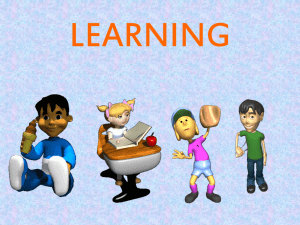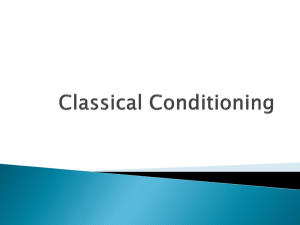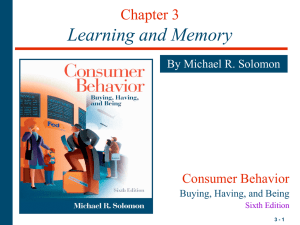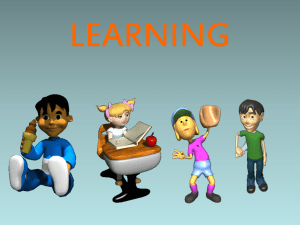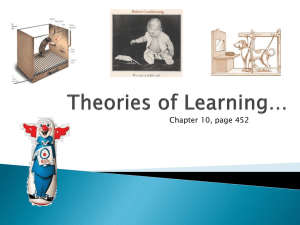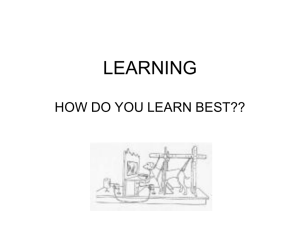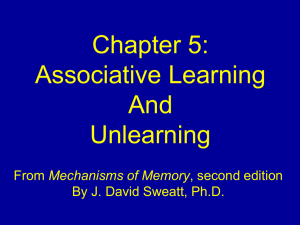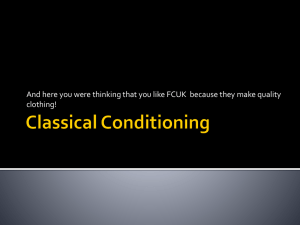3. Classical Conditioning
advertisement
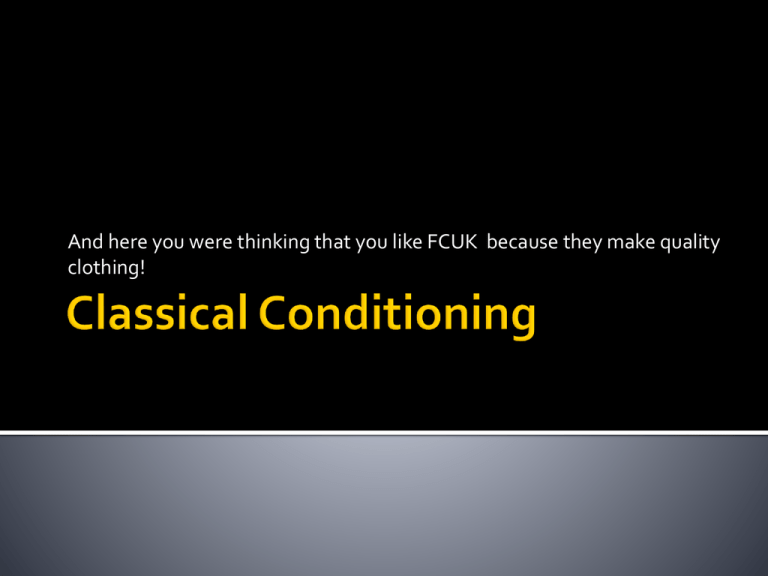
And here you were thinking that you like FCUK because they make quality clothing! A simple form of learning, which occurs through repeated association of two (or more) different stimuli Sometimes called “respondent conditioning” Learning is said to have occurred when a particular stimulus consistently produces a response that it did not previously elicit. Learn to associate two events, stimuli, eventually, one stands for the other in our minds. How does your dog know its time for a walk? Why do certain songs have meaning to different people? Why do people have phobias? Why cant I ever, ever, ever eat that again? Why do we buy ‘brand name’ products? ALL of these things are learned through classical conditioning! Advertisers are conditioning you to buy their product! The discovery of CC was an accident Pavlov (1899) wanted to study digestion and the role of saliva He was awarded the Nobel Prize in Physiology and Medicine in 1904 for his work. Flow of saliva occurred naturally when food (meat powder) was placed in the dog’s mouth (salivation is an involuntary reflex response) Rerouted saliva ducts to a test tube via a fistula (narrow opening in tissue) so measurements of saliva could be taken Dog was restrained in a harness to hold it in desired position and minimise influence of extraneous or potential confounding variables. Food placed in dog’s bowl and dog was observed by a series of mirrors so it could not see or be distracted by the observer. Early tests measured amount of saliva, later ones the rate (speed) of saliva flow also. Research ran into trouble when the dogs began to fill their cheek tubes before the food was presented The dogs were learning to anticipate food at the sight or sound of the lab tech guy who had been preparing their food. (e.g. Rattling of spoon against container as food was prepared). Clear evidence of a type of learning that was based on the repeated association of 2 different stimuli. A stimulus is any event that elicits (produces) a response from an organism. A response is a reaction by an organism to a stimulus. In Pavlov’s experiment: Stimulus of food Response of salivation But eventually: Stimulus became sight/ sound of lab tech Response produced was salivation Salivation response is controlled by autonomic division of PNS – it occurs involuntarily. Learning results by CC from linking the stimulus (that would not normally produce the response), over a number of trials, with a stimulus that normally produces the response automatically. Later experiments, Pavlov varied the stimulus and found the salivation response could be induced after repeated associations with a range of stimuli (e.g. Tug on hind leg, a bell, a light, or the sight of a circle) The Neutral Stimulus (NS) - the name given to the conditioned stimulus before it becomes conditioned. In Pavlov's experiment NS = Bell or Lab technician etc… The Conditioned Stimulus (CS) - the stimulus which is neutral at the start of conditioning. It wouldn't normally produce the Unconditioned response (UCR), but does so eventually because of its association with the Unconditioned Stimulus (UCS). CS = Bell or Lab technician etc… The Unconditioned Stimulus (UCS) - Any stimulus that consistently produces a particular response. In Pavlov's Exp. UCS = food. The Unconditioned Response (UCR) - A response which occurs automatically when the Unconditioned Stimulus is presented. In Pavlov's experiment. UCR = Salivation. The Continued Response (CR) - the behaviours which is identical to the UCR but is caused by the CS after conditioning. In Pavlov's expt. CR = Salivation in response to the Bell (CS). Association refers to the pairing or linking of one stimulus with another stimulus. E.g. Newborn infant can learn to associate appearance of mother’s breast, smell of mother’s breast of sight of a feeding bottle (CS) with the placement of nipple in infant’s mouth (UCS). After association is made between the stimulus and the pleasurable experience of feeding, the infant begins sucking (CR) in anticipation of the unlearned UCS. UCS – Walking UCR – Excitement UCS – Good times with friends UCR – Positive mood NS – Lead CS – Lead CR – Excitement NS – Song CS – Song CR – Positive mood The dog has learned to associate the dog lead with being taken for a walk We learn to associate the song with the good times we had UCS – Good looking people, fun, sexy, cool, happiness UCR – Feeling good / desire to be like this NS – Coke CS – Coke CR – Feeling Good about coke / desire to buy coke We learn to associate coke with positive images. Coke becomes meaningful and we are more likely to purchase it over other drinks UCS –Images of attractive, fit, cool, famous, successful, tough people UCR – Desire to achieve status of modes NS – Nike CS – Nike CR – Desire to achieve status of models /purchase Nike We learn to associate Nike with being fit, cool, fun, high status, successful thus we are more likely to purchase Nike over Big W brand because we do not associate Big W with any of these ideas UCS – rebellion, alternative, cool, counter culture UCR – feeling unique and hip NS – FCUK CS – FCUK CR – FCUK making us feel unique and hip We learn to associate FCUK with the image of rebellious cool, we are thus more likely to purchase FCUK over Target clothing. Because we are conditioned to see tangible value that is not there! Physically the products are often made from the same materials, sometimes even in the same factory (footwear and clothing especially) The value we perceive is emotional! Advertising adds emotional value to a product Coles-Myer executive quoted in response to an official enquiry – “non-branded footwear often incorporates the same or similar methods of construction, technology and components/materials. Moreover it is often sourced from the same factory as branded footwear. The commercial reality is that without a brand the consumer perceives no value that warrants a premium price.” Advertising executive – “If you think about what Pavlov did, he actually took a neutral object and, by associating it with a meaningful object, made it a symbol of something else, he imbued it with imagery, he gave it added value, and isn’t that what we try and do in modern advertising” On average people in western countries are exposed to 9000 advertising messages a day When subjects drank un branded cola only the taste sensing parts of the brain become active When subjects could see coke labelling the hippocampus (memory) and parts of the frontal lobe (emotions etc) also became active Recognition and positive reaction to Coke has been hard wired into the brain Nearly half of the worlds 8 – 12 year olds say that the clothes and brands they wear describe who they are! Advertising to children aims to create hard wired ‘brand loyalty’ If they get you young enough they can ensure that your brain becomes wired to prefer their product You then continue to purchase their product out of habit Acquisition is the overall process during which an organism learns to associate two events (CS and the UCS). During acquisition the CS and UCS occur close together in time and always in the same sequence. Duration of acquisition is usually measured by the number of trials it takes for the CR to be acquired (learned). (Each paired presentation of the CS with the UCS is referred to as a trial) Timing of CS and UCS is extremely important in the acquisition process. Pavlov found that a very short time between presentations of the two stimuli was most effective. Other studies show about ½ second is ideal with many different species. Acquisition is often more rapid when CS occurs and remains present until UCS is presented. End of acquisition is said to occur when the CS alone produces the CR. Conditioning is said to have taken place. A conditioned stimulus-response association is not necessarily permanent. Strength of the association may fade over time or disappear altogether. Extinction is the gradual decrease in the strength or rate of a CR that occurs when the UCS is no longer presented. Extinction has occurred when the UCS is no longer presented along with the CS Eventually the CS becomes meaningless CR stops Extinction has occurred when a CR no longer occurs following presentation of the CS. e.g. Pavlov’s dogs ceased salivating (CR) in response to bell (CS) presented alone after a number of trials in which the food (UCS) did NOT follow the sound of the bell. Extinction rates vary between individuals (people or animals) of the same conditioned response. There is also variation between rates at which different responses will be extinguished. Simple behaviours (tapping pen and blinking) can be extinguished more quickly than more complex behaviour patterns (intense fear of bathrooms due to association with cyclones). Extinction has occurred but is not always permanent. A rest period takes place. Spontaneous recovery is the reappearance of a CR when the CS is presented, following a rest period (when no CS is presented) after the CR appears to have been extinguished e.g. Eye blink could occur to sound of tapping alone without a puff of air CR is weaker than when first conditioned Spontaneous recovery does not always occur. When it does occur it is often short-lived. If extinction procedure is repeated several times, eventually the CR will disappear altogether and spontaneous recovery will not occur. The organism will respond by producing a CR to stimuli that are similar to the CS, but usually at a reduced level. Eg. Dogs in Pavlovs experiment would salivate to other noises that sounded like a bell (a chime, front door bell) Stimulus generalisation is the tendency for another stimulus (one similar to the original CS) to produce a response that is similar (but not necessarily identical) to the CR. Eg. A child who was bitten by a dog now fears all dogs not just pit bull terriers The greater the similarity between stimuli, the greater the possibility that a generalisation will occur. Evident in everyday life – e.g. Flinch at many forms of loud noise, many foods can make us salivate even if we’ve never eaten it before. Stimulus generalisation is rarely an intentional or even a conscious process but has a valuable adaptive role. e.g. Child burnt by lit match may generalise pain to other naked flames such as lit gas stove, fireplace etc. Stimulus generalisation can be detrimental or even harmful. E.g. Dog instinctively snaps at annoying flies may also snap at a wasp with painful consequences. E.g. Girl pecked by family’s pet duck may develop a bird phobia (intense, irrational fear) as an adult. This helps us understand why some fear responses can be triggered by non-threatening stimuli. Stimulus discrimination occurs when a person or animal responds to the CS only, but not to any other stimulus that is similar. Eg. Your dog gets excited when you put your Nike runners on, not any other white shoes Eg. Consumers only by coke, not any cola in red and white packaging EG. You only buy billabong, not the rip off surfalong brand E.g. Bite from a particular type of dog doesn’t cause fear for other breeds of dog. Ethical? Not really…. Classical conditioning is a systematic procedure through which associations between stimuli, or events in the environment, are learned, resulting in a conditioned response. It is a relatively simple type of learning. Behaviours that have been classically conditioned may occur so automatically that they appear to be reflexive. Pavlov used the term conditioned reflex to describe what is now known as the conditioned response. Classically conditioned responses are acquired through associative learning. (e.g. Brake lights on vehicle in front we learn is a signal the vehicle is slowing down and we put our foot on the brake as soon as we see the brake lights). Responses such as this involve anticipatory behaviour (same as Pavlov’s dogs salivating at sight of lab tech. in anticipation of food) Learning through classical conditioning may be involuntary and relatively simple but the responses are not as “thoughtless” or “mechanistic” as Pavlov thought. Pack your books at sound of bell Answer the phone when it rings Leave umbrella at home when there is a blue sky Flash of lightning signals impending thunder Specific tone indicates text message received Can also account for more complex behaviours such as fears and phobias. (e.g. Cringing at sound of dentist’s drill is a conditioned response based on previous experience/association with drill and potential pain) A conditioned emotional response is an emotional reaction that usually occurs when the autonomic nervous system produces a response to a stimulus that did not previously trigger that response. Drilling of tooth is the UCS Drill becomes the CS Conditioned emotional response is fear Some phobias are beneficial to your survival (e.g. Poisonous spiders) but others can be psychologically harmful (e.g. Fear of soft, furry animals or cuddles). Higher order conditioning has another level of associative process in classical conditioning, involving the introduction of another (or several) conditioned stimulus. (CS2) which is presented immediately after the first conditioned stimulus (CS1) until it alone produces the response. Before conditioning UCS (walk) leads to UCR (excitement) During conditioning (acquisition) UCS (walk) leads to CR (excitement) associated with CS1 (leash) Higher order conditioning CS1 (leash) leads to CR (excitement) associated with CS2 (small change rattled) The dog will eventually respond to the small change rattle alone (one CS is replaced with another). Can fears be learned? Yep! 1920 U.S. Psychologist John B. Watson and graduate student Rosalie Rayner. Test the elief that fears can be acquired through classical conditioning. Albert B (“Little Albert”) 11 month old son of woman who worked at same clinic as Watson. Albert was selected as he “practically never cried”, was stable and “on the whole stolid and unemotional”. The experiments on Albert were held irregularly over a 17 day period. UCS – Loud noise (banging steel bar) UCR – Fear NS – White Rat CS – White Rat CR – Fear Through repeated association (paring) of the loud noise and the white rat, little Albert learns to fear the white rat. The Rat becomes a signifier for the fear producing loud noise Watsons research would never be allowed today Beneficence – benefits outweigh the risks? Informed Consent – Albert’s mum didn’t know Debriefing – never happened as Albert’s mum left her job at the clinic and left the town (Baltimore) where the experiments were conducted. Withdrawal rights – Albert subjected to severe anxiety and stress but no attempt was made by the experimenters to end the experiment and attend to his distress in an appropriate way. No ethical guidelines or standards for professional conduct of researchers had been fully established at the time. Intense, irrational and persistent fears of specific objects of situations Phobias are complex instances of conditioned emotional responses (CC) UCS – 9/11 attack on World Trade Center UCR – fear NS – low flying planes CS – low flying planes CR – Fear / anxiety to low flying planes The trauma of witnessing the 9/11 attack has become associated with low flying planes now this alone causes fear. Research shows that damage to the amygdala impairs both the acquisition and expression of a conditioned fear response Amygdala involved in regulation of the fear response Amygdala involved in learning the emotional significance of an event / memory Can effect the consolidation of memory – stimulation better recall, retardation poorer recall In most cases, a CR acquired through classical conditioning will extinguish if the UCS is not paired with the CS at least occasionally. But sometimes, the association is so strong that it persists over time and intervention is needed to extinguish the association, particularly if the CR interferes with “normal” functioning in everyday life. (e.g. Fears) Psychologists have applied classical conditioning processes to develop therapies for treating phobias and other mental health problems where fear and/or anxiety play a prominent part. Exposure therapy is a therapeutic technique used to treat phobias and fears. One type of exposure therapy is graduated exposure which involves presenting successive approximations of the CS until the CS itself does not produce the CR. The client is gradually in a progressive way exposed to increasingly similar stimuli that produce the CR requiring extinction and ultimately to the CS itself. The client is gradually “desensitised” to the fear or anxiety producing object/event. Used to address fear of flying, fear of heights, public speaking anxiety, paruresis (shy bladder syndrome). Steps: 1. Therapist and client work to “break down” then organise the anxiety/fear into a hierarchy of increasingly difficult encounters. 2. Step by step exposure to each fear producing situation, starting with the least frightening. Done at client’s own pace with support from therapist. It may involve imagining each situation using visual imagery (imaginal exposure), real-life exposure (in vivo exposure) or use of virtual reality technology. Best results appear to occur with real-life graduated exposures. E.g. Fear of flying – therapist might sit on the plane with the client, then may take their first flight together while therapist helps person remain calm and engage in muscle relaxation. The therapist might arrange for the client to meet with the pilot for reassurance. By confronting their fears with support, the client learns to tolerate the fearful situations or stimuli and the fear (of flying in the above example) is eventually overcome. GRADUATED EXPOSURE Attempts to replace fear response with relaxation patient taught relaxation techniques gradually introduced to fear inducing stimulus while practicing relaxation. FLOODING Paruresis is an anxiety disorder that involves difficulty or inability to urinate when another person (or people) are around. No difficulty urinating at home alone, but may experience hesitancy or difficulty when visitors are in their home. Public facilities cause most difficulty. It is a type of “social phobia” involving performance anxiety not unlike “stage fright”. It causes distress during everyday activities and interferes significantly with a person’s ability to conduct everyday activities. It is a common type of social phobia, ranking second only to fear of public speaking. Up to 7% of population (1.5 million Australians) may experience a mild, moderate or severe form of paruresis. FLOODING Flooding is another type of exposure therapy, that involves bringing the client into direct contact with the anxiety or fear producing stimulus then keeping them in contact with it until the CR is extinguished. Expose the patient to their fear straight away They will panic at first Contact may take up to 2 hours or more and can be in vivo, imagined or using virtual reality devices. Soon realise that nothing bad has happened Aversion is a complete dislike for something. Aversion therapy is a form of behaviour therapy that applies classical conditioning principles to inhibit (“block”) or discourage undesirable behaviour by associating it with unpleasant stimulus (e.g. feeling of disgust, nausea or pain). The aim is to weaken or suppress the undesirable behaviour. E.g. nail biting and foul tasting substance Sometimes used to treat alcohol abuse or smoking UCS – Drug UCR – Nausea NS – Alcohol CS – Alcohol CR – nausea The alcoholic learns to associate alcohol with the drug induced nausea experience Wiens and Menustick (1983) treated 685 participants with aversion therapy for alcohol addiction with a nausea-inducing drug. 1 year later – 2/3 not had an alcoholic drink 3 years later – 1/3 not had an alcoholic drink Baker (1981) suggested that drugs which cause intestinal distress are more effective in establishing aversion than external sources such as electric shocks. Using aversion therapy to quit smoking, a client might smoke a cigarette from a device that also holds a second cigarette containing a nausea-inducing chemical. Short term results may only occur though, as the client may learn that the nausea is only experienced when they smoke two cigarettes in this type of apparatus, not when they smoke a regular, single cigarette. Conflicting results: Forrest (1985) used a drug called Antabuse (causes severe flushing dizziness, nausea and headaches) shortly after alcohol consumption in aversion therapy research. Longitudinal studies (long term) indicate that chronic alcoholics tend to avoid alcohol while on Antabuse but tend to return to drinking alcoholo after stopping taking the drug. The learned aversion often fails to generalise to situations other than those under which the learning took place. This may be due to the conditioning being dependent on cues that indicate the aversive stimulus will follow. First used in the 1930’s to treat alcoholism – individuals with alcohol addiction given an aversive stimulus (painful electric shocks) whenever they could see, smell or taste alcohol. Today, instead of electric shocks, nauseainducing drugs are paired with alcohol consumption to make the individual feel ill. Alex is a violent criminal who undergoes aversion therapy as part of his sentence for murder UCS – Drug UCR – Nausea NS – Violence CS – Violence CR – Nausea Alex learns to associate violence with the drug induced nausea thus making him aversive to violence Using PET and fMRI studies have founds that classical conditioning activates areas of the cerebral cortex and lower brain structures including the cerebellum, thalamus, hippocampus, hypothalamus, and amygdala. Tone (NS) paired with shock to write (UCS) showed on PET scans specific areas of the frontal lobe in the right hemisphere were activated. Neutral words (no conditioning) presented with threat related words (conditioning) showed in fMRI that threat words activated a different part of the cerebral cortex than neutral words. Studies on eye-blink conditioning show the cerebellum is activated (as it plays a vital role in maintaining co-ordinated movement and balance). Fear studies show that the amygdala is activated indicated on fMRI when fearful faces shown rather than neutral faces. So was an area of the frontal lobe involved in interpreting emotions. Never ever, ever, ever, ever, ever again! A taste aversion is a conditioned response that results from a person or animal establishing an association between a particular food and being or feeling ill after having consumed it at some time in the past. The association is usually the result of a single experience and the particular food will be avoided in the future. Taste aversion arises from a learning experience that is similar to classical conditioning (association between a CS (smell/taste of food) and UCS (nausea producing substance)) Difference is it tends to happen after just one “trial”. Same mechanism as CC Takes only one pairing Resistant to extinction Not often generalised Most common examples are aversions to foods One trial learning is a type of learning involving a relatively permanent change in behaviour that occurs as a result of one experience only. It is like but IS NOT a type of classical conditioning. CC takes several trials and responses can extinguish relatively quickly One trial learning occurs after one trial only and is considerably resistant to extinction (due to very powerful response – feeling or being ill). Classical conditioning associations between CS and UCS occur closer together whereas one trial learning the CR can occur as late as a day or so after the CS is consumed but is mentally associated. The ability to generalise the CS to other similar stimuli occurs in classical conditioning but not in one trial learning. In taste aversion acquired through one trial learning, other stimuli do not substitute for food as the CS. Conditioning of a taste aversion is sometimes known as the “Garcia effect” after US psychologist John Garcia who pioneered it’s research. Garcia suggests that animals tend to associate aversive stimuli in certain ways that foster their survival, but do not associate aversive stimuli if these do not threaten their survival. Learned taste aversions based on just one experience can be very adaptive – animals that learn quickly what not to eat/drink will probably live longer and produce more offspring. Garcia and Koelling (1966) used 20 thirsty 90 day old male rats. 2 experimental groups – both groups offered saccharine flavoured water to drink from a tube and when rats in both groups licked the tube they heard an unfamiliar clicking noise and a bright light flashed. One group though had this paired with receiving a painful shock to their feet and the other group paired this with a dose of illness-inducing radiation via X-rays. All rats refused the saccharine flavoured water when offered on a subsequent occasion. They had seemed to develop a taste aversion to saccharine flavoured water. Next, Garcia and Koelling tested same rats under a different condition. Rats were given either saccharine flavoured water NOT paired with light or noise OR unflavoured water that WAS paired with same light and noise as previously used. Rats who had originally received electric shock refused water when given with light and noise but had no objection to saccharine flavour. Rats who had become ill from radiation avoided the saccharine flavour but were content to drink water accompanied by light and noise. Results indicated that the UCS influenced what the rats had learned. Suggests that rats may tend to associated stimuli in particular ways that foster survival.

